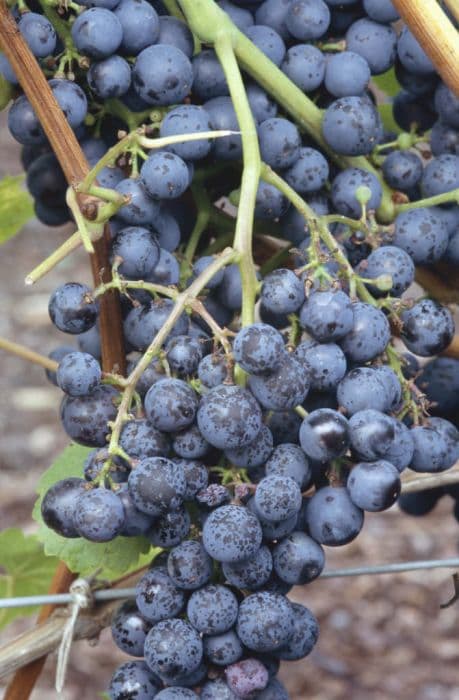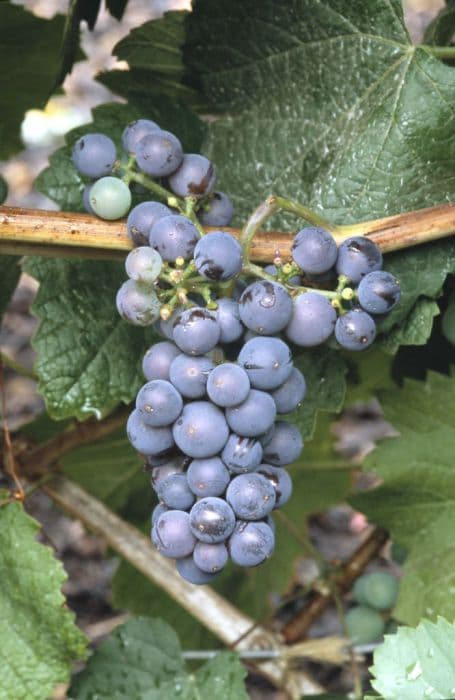Müller-Thurgau grape Vitis vinifera 'Müller-thurgau' (O/w)

ABOUT
Müller-Thurgau, a variety of grapevines, has a distinct appearance characterized by its lush, green foliage and the clusters of grapes it produces. The leaves are typically broad, with a heart-shaped base and serrated edges. They are a vibrant green color that can add a lush look to any vineyard landscape. The grape clusters themselves range from green to yellowish, depending on the ripeness, and are made up of small to medium-sized grapes with a thin skin. These clusters hang from the vines and can be quite dense, creating a picturesque scene especially as they start to ripen. The grapes are known for their floral aroma and slightly sweet flavor, which is why they're often used in white wine production. The vines themselves can be trained along trellises or wires to maximize sun exposure and air circulation, which is beneficial for the health and productivity of the plant. Overall, the appearance of the Müller-Thurgau grapevine is one that is intertwined with agrarian charm and the promise of a delightful harvest.
About this plant
 Names
NamesFamily
Vitaceae
Synonyms
Müller-Thurgau, Rivaner
Common names
Vitis vinifera 'Müller-Thurgau'
 Toxicity
ToxicityTo humans
Müller-Thurgau, a variety of grapevine, is not considered toxic to humans when consumed as the fruit grapes or wine in moderation. However, like all grapevines, other parts of the plant such as leaves, stems, and seeds contain compounds like tannins and may contain traces of pesticides or herbicides used during cultivation. In large amounts, these can cause stomach upset or allergic reactions in sensitive individuals. The primary concern lies in the overconsumption of the fruit in the form of wine, which can lead to alcohol poisoning and its associated risks.
To pets
Müller-Thurgau, commonly referred to as grapevine when discussing pet toxicity, is toxic to dogs and cats. Consumption of grapes or raisins by pets can lead to acute kidney failure. Symptoms of poisoning include vomiting, diarrhea, lethargy, loss of appetite, abdominal pain, and severe kidney failure, which can be fatal. Even small amounts can be dangerous, so prompt veterinary attention is required if a pet has ingested grapes or raisins.
 Characteristics
CharacteristicsLife cycle
Perennials
Foliage type
Deciduous
Color of leaves
Green
Flower color
Greenish-yellow
Height
4-6 feet (1.2-1.8 meters)
Spread
3-5 feet (0.9-1.5 meters)
Plant type
Climber
Hardiness zones
7-11
Native area
Europe
Benefits
 General Benefits
General Benefits- Produces Grapes: The 'Müller-Thurgau' grapevine is a cultivar known for producing high-quality grapes used for winemaking, particularly for white wines with a distinctive floral aroma.
- Landscape Ornamentation: This plant can serve as an ornamental feature in landscapes due to its attractive vines, lush green foliage, and clusters of grapes.
- Economical Crop: It is an economically valuable crop for vineyards and wineries, contributing significantly to the wine industry and local economies.
- Shade Provider: With its extensive canopy, the plant can offer shade and create cooler areas in gardens, which can reduce local temperatures and provide a pleasant outdoor space.
- Habitat for Wildlife: The vines can provide a habitat for various wildlife species, including birds and beneficial insects, which can help in maintaining the ecosystem's balance.
- Erosion Control: The extensive root system of grapevines can help in preventing soil erosion, making it valuable for planting in slopes or areas prone to erosion.
- Educational Value: Vitis vinifera 'Müller-Thurgau' can be used for educational purposes, teaching viticulture, horticulture, and the process of winemaking.
- Cultural Significance: Grapevines have a deep cultural and historical significance in many regions, symbolizing abundance and transformation.
 Medical Properties
Medical PropertiesThis plant is not used for medical purposes.
 Air-purifying Qualities
Air-purifying QualitiesThis plant is not specifically known for air purifying qualities.
 Other Uses
Other Uses- Vitis vinifera, commonly known as grapevine, can be used as a natural dye for fabrics, providing a range of colors from greens to browns depending on the mordant used.
- In landscaping, the grapevine is used to create living fences or privacy screens due to its dense foliage and fast growth habit.
- The flexible woody vines, or canes, are used in traditional crafts for weaving baskets, furniture, and even artistic sculptures.
- Grapevine leaves are used in culinary arts, especially in Mediterranean cuisines, to wrap foods such as rice, meat, or vegetables for stuffed grape leaves known as dolmas.
- The wood from old grapevine trunks is valued for creating eco-friendly barbecue smoking chips, imparting a unique flavor to smoked foods.
- Vitis vinifera can be trained to grow over arbors and pergolas, providing shade in garden seating areas and walkways.
- Grapevines are sometimes planted for erosion control on slopes and hillsides due to their extensive root system.
- The high sugar content in the grapes can be used for the fermentation process in making bioethanol, a form of renewable energy.
- Mature grapevines can be used as a natural play structure for children, who can climb and explore the sturdy vines.
- Grape pomace, the solid remains after juicing, can be composted and used as a nutrient-rich soil amendment in gardens.
Interesting Facts
 Feng Shui
Feng ShuiThe grapevine is not used in Feng Shui practice.
 Zodiac Sign Compitability
Zodiac Sign CompitabilityThe grapevine is not used in astrology practice.
 Plant Symbolism
Plant Symbolism- Fertility: The grapevine, in general, is often associated with fertility and abundance due to its characteristic of producing many grapes.
- Vitality: Grapes are known for their life-sustaining qualities and robust growth, symbolizing vitality and vigorous life.
- Prosperity: The abundance of grapes upon harvest translates to the symbol of prosperity and wealth.
- Celebration: The Müller-Thurgau grape is used to produce wine, which is commonly associated with celebrations and joyous occasions.
- Transformation: As grapes ferment to become wine, they embody transformation and change, both literally and metaphorically.
- Eternal Life: Wine, especially in religious contexts, can represent eternal life and spirituality.
 Water
WaterRiesling vines require consistent moisture, especially during the growing season. Aim to water the plant deeply once a week, providing approximately 1.5 gallons per plant to ensure the soil is moist but not waterlogged. During hot and dry periods, increase the frequency to twice a week, monitoring the soil moisture level to avoid overwatering. During the dormant season, reduce watering to every two to three weeks depending on rainfall. Always water at the base of the vine to minimize the risk of fungal diseases on the leaves that can result from overhead watering.
 Light
LightRiesling grapevines thrive in full sun with at least 6 to 8 hours of direct sunlight per day. Choose a spot that is south-facing if possible, ensuring that the vine receives ample light throughout the day. Avoid locations where buildings, trees or other structures will cast shade on the vine, as insufficient sun can lead to poor fruit development and increase susceptibility to disease.
 Temperature
TemperatureRiesling vines prefer temperate conditions and can typically tolerate temperatures as low as 20°F before sustaining damage. The ideal temperature range for Riesling is between 55°F and 75°F, which promotes optimal growth and fruit production. When temperatures exceed 85°F, it's important to provide adequate water to prevent heat stress and maintain healthy vines.
 Pruning
PruningPrune Riesling vines during dormancy in late winter to early spring to promote healthy growth and manage the size and shape of the vine. Adequately pruning the vine once a year helps in regulating fruit production and ensures air circulation, which reduces the risk of disease. The best time for pruning is when the risk of severe frost has passed but before the sap starts to flow.
 Cleaning
CleaningAs needed
 Soil
SoilMüller-Thurgau, commonly known as Riesling-Sylvaner, thrives best in deep, fertile, and well-draining soil with a pH around 5.5 to 7.0. For optimal growth, use a mix of loamy soil enriched with compost and aged manure to provide balanced nutrition. Ensure the soil offers good moisture retention while allowing excess water to drain to prevent root rot.
 Repotting
RepottingRiesling-Sylvaner grapevines typically do not need to be repotted if they are planted in the ground. However, if grown in containers, repotting should be done every 2-3 years in late winter or early spring to replenish soil nutrients and accommodate root growth.
 Humidity & Misting
Humidity & MistingRiesling-Sylvaner grapevines prefer moderate humidity levels but are adaptable to a range of conditions. Maintaining ambient outdoor humidity around 50-70% is generally suitable for these vines.
 Suitable locations
Suitable locationsIndoor
Grow Riesling-Sylvaner indoors with ample light, training on a trellis.
Outdoor
Plant Riesling-Sylvaner grapes in full sun, with support, well-drained soil.
Hardiness zone
7-9 USDA
 Life cycle
Life cycleThe common name for Vitis vinifera 'Müller-Thurgau' is Müller-Thurgau grapevine. Initially, it begins with seed germination, where the seeds sprout roots and shoots after being exposed to the right conditions. This is followed by the vegetative growth stage, where the vine develops its root system, stems, and leaves; it is a critical phase for accumulating the resources necessary for fruit production. When the plant reaches maturity, the flowering stage occurs, and flowers are produced that are then pollinated, leading to fruit set. The subsequent fruit development stage sees the growth and ripening of grapes, which is when sugar content increases and the grapes become suitable for harvesting. Finally, the dormancy period sets in, usually during the colder months, where the grapevine's growth activities slow down, and it prepares to start the cycle again with the return of warmer weather.
 Propogation
PropogationPropogation time
Spring to Summer
Propogation: The Müller-Thurgau grapevine, commonly known just as Müller-Thurgau, is most typically propagated through the method of hardwood cuttings. This is generally done during the grapevine's dormant period which is late winter, prior to the onset of the spring growth. To propagate by this method, select healthy, mature canes from the previous year's growth. These canes should be cut into sections approximately 12 to 18 inches (30 - 46 cm) long, making sure each cutting has at least two or three buds. These cuttings are then planted either in pots with soil or directly in the nursery row in the vineyard, where they will develop roots and shoots over the spring and can eventually be transplanted to their final position in the vineyard.









